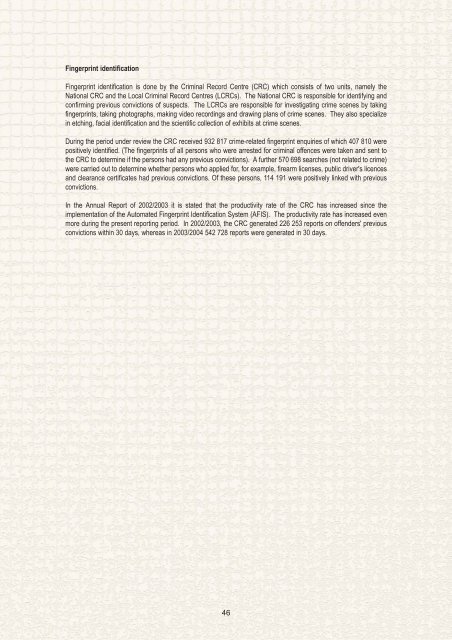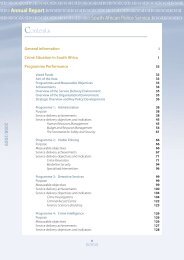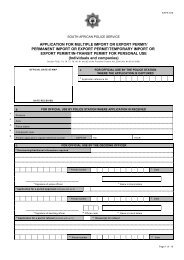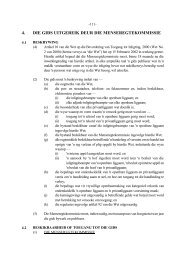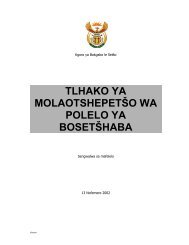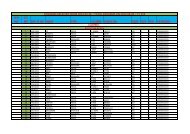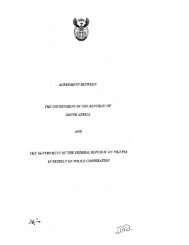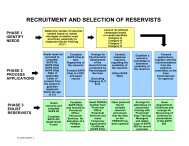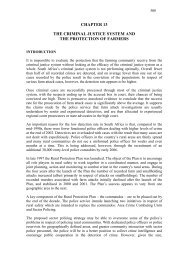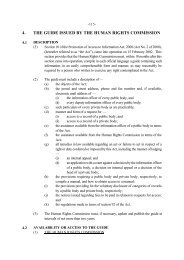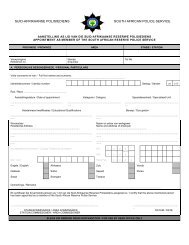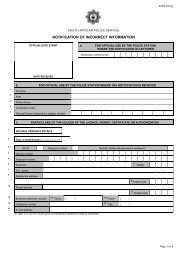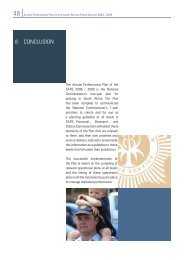Fingerprint identification Fingerprint identification is done by ... - Saps
Fingerprint identification Fingerprint identification is done by ... - Saps
Fingerprint identification Fingerprint identification is done by ... - Saps
You also want an ePaper? Increase the reach of your titles
YUMPU automatically turns print PDFs into web optimized ePapers that Google loves.
<strong>Fingerprint</strong> <strong>identification</strong><br />
<strong>Fingerprint</strong> <strong>identification</strong> <strong>is</strong> <strong>done</strong> <strong>by</strong> the Criminal Record Centre (CRC) which cons<strong>is</strong>ts of two units, namely the<br />
National CRC and the Local Criminal Record Centres (LCRCs). The National CRC <strong>is</strong> responsible for identifying and<br />
confirming previous convictions of suspects. The LCRCs are responsible for investigating crime scenes <strong>by</strong> taking<br />
fingerprints, taking photographs, making video recordings and drawing plans of crime scenes. They also specialize<br />
in etching, facial <strong>identification</strong> and the scientific collection of exhibits at crime scenes.<br />
During the period under review the CRC received 932 817 crime-related fingerprint enquiries of which 407 810 were<br />
positively identified. (The fingerprints of all persons who were arrested for criminal offences were taken and sent to<br />
the CRC to determine if the persons had any previous convictions). A further 570 698 searches (not related to crime)<br />
were carried out to determine whether persons who applied for, for example, firearm licenses, public driver's licences<br />
and clearance certificates had previous convictions. Of these persons, 114 191 were positively linked with previous<br />
convictions.<br />
In the Annual Report of 2002/2003 it <strong>is</strong> stated that the productivity rate of the CRC has increased since the<br />
implementation of the Automated <strong>Fingerprint</strong> Identification System (AFIS). The productivity rate has increased even<br />
more during the present reporting period. In 2002/2003, the CRC generated 226 253 reports on offenders' previous<br />
convictions within 30 days, whereas in 2003/2004 542 728 reports were generated in 30 days.<br />
46
PROGRAMME 5: CRIME INTELLIGENCE<br />
Seeing that Crime Intelligence <strong>is</strong> the fastest growing programme in the Safety and Security budget, the SAPS has<br />
establ<strong>is</strong>hed it as a separate div<strong>is</strong>ion in the Vote as from 2003/2004.<br />
Purpose<br />
To provide for the management of crime intelligence, the analys<strong>is</strong> of crime information and the prov<strong>is</strong>ion of technical<br />
support for crime-prevention operations and investigations.<br />
The subprogrammes in th<strong>is</strong> programme are -<br />
- Crime Intelligence Operations which <strong>is</strong> responsible for gathering intelligence and counter-intelligence; and<br />
- Intelligence and Information Management which <strong>is</strong> responsible for analysing crime intelligence and for<br />
managing the Crime Intelligence Management Centre.<br />
Measurable objectives<br />
To gather, collate and analyse intelligence/information to generate reports that contribute to the neutralization of crime<br />
threats.<br />
Service delivery output, indicators and achievements<br />
Table 23: Output and indicators<br />
Measurable objective: To gather, collate and analyse intelligence/information to generate reports that contribute to<br />
the neutralization of crime threats.<br />
Subprogramme Output Measure/Indicator Target<br />
Crime Intelligence Operations<br />
Neutralized threats<br />
Percentage of reports generated that <strong>is</strong><br />
used to positively neutralize threats 7<br />
To be benchmarked in 2003/2004<br />
Intelligence and Information<br />
Management<br />
Crime intelligence products<br />
Number of reports generated to prevent<br />
and investigate crime threats<br />
Maintain or increase in 2003/2004<br />
The neutralization of threats<br />
Crime threats are addressed on various levels of activity through overt or covert intelligence operations. Intelligence<br />
analyses regarding all types of organized crime are provided to operational units on an ongoing bas<strong>is</strong>. Forty-two<br />
undercover operations were reg<strong>is</strong>tered/investigated in the 2003/2004 financial year at Crime Intelligence. These<br />
operations focused on drugs, vehicles, corruption, multidimensional criminal activity, extrem<strong>is</strong>m, firearms,<br />
housebreaking, stock theft, and diamond smuggling. Significant results of these operations included the detection<br />
and closure of 51 drug laboratories and the recovery of more than 11 061 firearms.<br />
Crime Intelligence launched a total of 6 372 operations aimed at preventing crime in the 2003/2004 financial year to<br />
address threats relating to drugs, firearms, stock theft, housebreaking, corruption among State officials, theft of motor<br />
vehicles, hijacking of motor vehicles, armed robbery, domestic and transnational extrem<strong>is</strong>m, and dealing in human<br />
body parts. These operations, which were conducted on an ongoing bas<strong>is</strong>, not only led to the detection and arrest of<br />
suspects and the recovery of goods, but also served as an effective crime deterrent.<br />
7<br />
During the monitoring process, the SAPS found that th<strong>is</strong> indicator does not provide the correct information and it was therefore changed to "Number of<br />
operations conducted to neutralize crime threats".<br />
47
Crime intelligence products<br />
In the financial year under review, Crime Intelligence produced a total of 172520 8<br />
products.<br />
Strategic intelligence and information products<br />
These products were provided to the National Comm<strong>is</strong>sioner, the Min<strong>is</strong>ter for Safety and Security, the Presidency, and<br />
political dec<strong>is</strong>ion makers. In the 2003/2004 financial year, Crime Intelligence produced 314 strategic intelligence<br />
reports. The strategic intelligence reports highlighted crime trends and patterns, and guided the deployment of<br />
resources.<br />
Tactical information/intelligence reports<br />
Tactical intelligence refers to intelligence used <strong>by</strong> operational units to address threats/<strong>is</strong>sues such as the whereabouts<br />
of wanted suspects. In the financial year under review, Crime Intelligence produced 80 812 tactical intelligence<br />
reports. Tactical intelligence reports guided operational units to specific locations and individuals linked to criminal<br />
activities, leading to the arrest of wanted suspects and suspicious persons such as drug couriers.<br />
Crime prevention information/intelligence reports<br />
Crime prevention intelligence/information reports are forwarded to operational units for purposes of preventing the<br />
perpetration of certain criminal acts. In the 2003/2004 financial year, 64 051 crime prevention/intelligence reports<br />
were produced and forwarded to operational units. As a result of crime prevention/intelligence reports, crimes such<br />
as bank robberies, cash-in-transit he<strong>is</strong>ts, taxi-related attacks, and faction-related attacks have been prevented.<br />
Information products<br />
Crime Intelligence structures produced a total of 27 343 information reports in the 2003/2004 financial year. These<br />
reports ass<strong>is</strong>ted div<strong>is</strong>ional comm<strong>is</strong>sioners and provincial comm<strong>is</strong>sioners in making dec<strong>is</strong>ions relating to the<br />
<strong>identification</strong> of crime-prone areas and the deployment of resources to address crime in identified areas.<br />
The success that Crime Intelligence achieves <strong>is</strong> not necessarily manifest at the conclusion of an operation or project.<br />
Information that Crime Intelligence gathers and supplies to the Detective Service may lead to further investigations<br />
and court cases. The successful results of an operation or project might only become apparent at the conclusion of<br />
a court case, which could be a considerable time after the operation or project has ended.<br />
8<br />
Th<strong>is</strong> figure must be interpreted in the context of the functions of Crime Intelligence. Thus, for example, more than 200 reports can be aimed at a specific<br />
crime threat.<br />
48
PROGRAMME 6: PROTECTION AND SECURITY SERVICES<br />
Purpose<br />
To render protection services to foreign and local prominent people.<br />
Th<strong>is</strong> programme cons<strong>is</strong>ts of the following two subprogrammes:<br />
• The Presidential Protection Unit which provides protection services for the President, the Deputy President<br />
and former presidents and their spouses.<br />
• Static and In-transit Protection which protects local and foreign VIPs.<br />
Measurable objectives<br />
To protect foreign and local prominent people in order to prevent security breaches<br />
Service delivery output, indicators and achievements<br />
Table 24: Output and indicators<br />
Subprogramme Output Output measure/Indicator Target Actual<br />
Presidential Protection Unit Prov<strong>is</strong>ion of protection Security breaches<br />
0%<br />
0%<br />
services to President,<br />
Deputy President and Number of complaints lodged <strong>by</strong> 0%<br />
0%<br />
former presidents<br />
President, Deputy President and former<br />
presidents<br />
Static and In-transit<br />
Protection<br />
Prov<strong>is</strong>ion of protection<br />
services to prominent<br />
people<br />
Security breaches<br />
Number of complaints lodged <strong>by</strong><br />
President, Deputy President and<br />
former presidents<br />
0%<br />
0%<br />
Five<br />
Six<br />
Protection Services has provided protection to 180 local dignitaries, 93 foreign dignitaries and 98 heads of state and<br />
heads of government. Protection was provided for numerous VIPs at 99 special and major events.<br />
Five incidences of security breaches occurred (housebreaking related) and are being investigated <strong>by</strong> the SAPS.<br />
Six complaints were lodged against members of Protection Services. Investigations into the complaints revealed that<br />
it was not necessary to take departmental steps against the members involved. In each instance, the situation was<br />
rectified <strong>by</strong> means of in-service training and the redeployment of members.<br />
In the course of the 2003/2004 financial year, Cabinet approved the mandate, functions and responsibilities of the<br />
Div<strong>is</strong>ion: Protection and Security Services. In th<strong>is</strong> regard, monetary prov<strong>is</strong>ion was made for projects relating to<br />
security at key government installations that are to be rolled out during the 2004/2005 financial year. Functions<br />
relating to ports of entry, security and railway police, as well as the transfer of the functions of the government<br />
security regulator from the SANDF, will form part of the pilot projects.<br />
Output measures and indicators for the ex<strong>is</strong>ting functions of the programme were developed for the 2004/2005<br />
financial year. The outcome of the pilot projects will set the baseline for performance measurement in the future.<br />
Control will be exerc<strong>is</strong>ed at ports of entry and borders in terms of policies, procedures, operational standards and<br />
standing operational procedures presented <strong>by</strong> a forum compr<strong>is</strong>ing Protection and Security Services, Operational<br />
Response Services, Crime Prevention, Crime Intelligence and the Detective Services. The forum will ensure that the<br />
rendering of security services at these key points takes place in an integrated manner.<br />
49
REPORT OF THE AUDIT COMMITTEE<br />
50
Report of the Audit Committee for the year ended 31 March 2004<br />
The Audit Committee reports in terms of section 38(1)(a) of the PFMA and treasury regulation 3.1.13 and 27(1)(10)<br />
that it has adopted appropriate formal terms of reference as it’s audit committee charter, and has regulated its affairs<br />
in compliance with th<strong>is</strong> charter, and has d<strong>is</strong>charged all of its responsibilities contained therein.<br />
The audit committee cons<strong>is</strong>t of the members l<strong>is</strong>ted hereunder and meets (4) four times per annum as per its approved<br />
terms of reference. During the current year, (4) four meetings were held.<br />
Name of Member<br />
Number of Meetings Attended<br />
J Kathan (chairperson: resigned 1 August 2003) 1<br />
DR L Konar (chairperson: appointed 1 August 2003) 3<br />
L J Eloff (Deputy National Comm<strong>is</strong>sioner) 3<br />
K L Craemer (Chief Financial Officer) 3<br />
S Mhlarhi 2<br />
B Coka (appointed 29 January 2004) 1<br />
In the conduct of its duties, the Audit Committee has, inter alia, reviewed the following:<br />
• The effectiveness of the internal control systems;<br />
• The effectiveness of the recently establ<strong>is</strong>hed internal audit function;<br />
• The r<strong>is</strong>k areas of the entity's operations covered in the scope of internal and external audits;<br />
• The adequacy, reliability and accuracy of financial information provided <strong>by</strong> management and other users of<br />
such information;<br />
• Accounting and auditing concerns identified as a result of internal and external audits;<br />
• The entity's compliance with legal and regulatory prov<strong>is</strong>ions;<br />
• The activities of the internal audit function, including its annual work programme, co-ordination with the<br />
external auditors, the reports of significant investigations and the responses of management to specific<br />
recommendations; and<br />
• The independence and objectivity of the internal and external auditors.<br />
The Audit Committee <strong>is</strong> of the opinion, based on the information and explanations supplied <strong>by</strong> management and the<br />
internal auditors and d<strong>is</strong>cussions with the independent external auditors on the result of their audits the status in<br />
addressing the matters ra<strong>is</strong>ed <strong>by</strong> SCOPA, that the internal accounting controls are operating and need strengthening<br />
and improvement to ensure that the financial records may be relied upon for preparing the annual financial<br />
statements, and accountability for assets and liabilities <strong>is</strong> maintained.<br />
Nothing significant has come to the attention of the Audit Committee other than the matters referred to in the<br />
Auditor-General's report to indicate that any material breakdown in the functioning of these controls, procedures and<br />
systems has occurred during the year under review.<br />
The Audit Committee has evaluated the annual financial statements of the Department of Safety and Security for the<br />
year ended 31 March 2004 and, based on the information provided to the Audit Committee, considers that it complies,<br />
in all material respects, with the requirements of the Police Act, Act 68 of 1995, and the Public Finance Management<br />
Act, 1 of 1999, (as amended <strong>by</strong> Act 29 of 1999) and South African Statements of Generally Recogn<strong>is</strong>ed Accounting<br />
Practice. The Audit Committee concurs that the adoption of the going concern prem<strong>is</strong>e in the preparation of the<br />
annual financial statements <strong>is</strong> appropriate. At their meeting held on 30 July 2004 the Audit Committee recommended<br />
the adoption of the annual financial statements <strong>by</strong> the Department of Safety and Security.<br />
Dr L Konar<br />
Chairperson<br />
2004-07-30<br />
51
AUDITOR - GENERAL<br />
REPORT<br />
OF THE<br />
AUDITOR-GENERAL<br />
TO PARLIAMENT<br />
ON THE FINANCIAL STATEMENTS OF VOTE 25 -<br />
DEPARTMENT OF SAFETY AND SECURITY<br />
FOR<br />
THE YEAR ENDED 31 MARCH 2004<br />
52
REPORT OF THE AUDITOR-GENERAL TO PARLIAMENT ON THE FINANCIAL STATEMENTS OF VOTE 25 -<br />
DEPARTMENT OF SAFETY AND SECURITY FOR THE YEAR ENDED 31 MARCH 2004<br />
1. AUDIT ASSIGNMENT<br />
The financial statements as set out on pages [ 1] to [29 ], for the year ended 31 March 2004, have been audited in<br />
terms of section 188 of the Constitution of the Republic of South Africa, 1996 (Act No. 108 of 1996), read with sections<br />
3 and 5 of the Auditor-General Act, 1995 (Act No. 12 of 1995). These financial statements, the maintenance of<br />
effective control measures and compliance with relevant laws and regulations are the responsibility of the accounting<br />
officer. My responsibility <strong>is</strong> to express an opinion on these financial statements, based on the audit.<br />
2. NATURE AND SCOPE<br />
The audit was conducted in accordance with Statements of South African Auditing Standards. Those standards<br />
require that I plan and perform the audit to obtain reasonable assurance that the financial statements are free of<br />
material m<strong>is</strong>statement.<br />
An audit includes:<br />
• examining, on a test bas<strong>is</strong>, evidence supporting the amounts and d<strong>is</strong>closures in the financial statement,<br />
• assessing the accounting principles used and significant estimates made <strong>by</strong> management, and<br />
• evaluating the overall financial statement presentation.<br />
Furthermore, an audit includes an examination, on a test bas<strong>is</strong>, of evidence supporting compliance in all material<br />
respects with the relevant laws and regulations which came to my attention and are applicable to financial matters.<br />
I believe that the audit provides a reasonable bas<strong>is</strong> for my opinion.<br />
3. QUALIFICATION<br />
Leave entitlement<br />
Deficiencies were noted in the management and admin<strong>is</strong>tration of leave in all the provinces. Th<strong>is</strong> had an impact on<br />
the calculation of the leave entitlement. Leave forms were not captured on the Personnel and Salary system<br />
(PERSAL) in every province v<strong>is</strong>ited. At a specific station, a backlog of five months ex<strong>is</strong>ted in the processing of leave<br />
applications, while the manual leave reg<strong>is</strong>ter had last been updated in 2002.<br />
It was not possible to quantify the effects of these findings, nor was it possible to perform alternative audit procedures.<br />
I am therefore unable to sat<strong>is</strong>fy myself as to the accuracy and completeness of the leave entitlement of R4.029<br />
billion as d<strong>is</strong>closed in Note 23 to the financial statements.<br />
4. QUALIFIED AUDIT OPINION<br />
In my opinion, except for the effect on the financial statements of the matters referred to in paragraph 3, the financial<br />
statements fairly present, in all material respects, the financial position of the Department of Safety and Security at<br />
31 March 2004, and the results of its operations and cash flows for the year then ended, in accordance with prescribed<br />
accounting practice and in the manner required <strong>by</strong> the Public Finance Management Act, 1999 (Act No. 1 of 1999).<br />
5. EMPHASIS OF MATTER<br />
Without further qualifying the audit opinion expressed above, attention <strong>is</strong> drawn to the following matters:<br />
5.1 Non-compliance with policies, procedures and standing instructions:<br />
5.1.1 Personnel expenditure<br />
• Inadequate document management resulted in m<strong>is</strong>sing <strong>identification</strong> documents and appointment letters on<br />
personnel files of newly appointed staff. Official procedures and guidelines governing appointments were also<br />
not cons<strong>is</strong>tently applied.<br />
• Some members whose services had been terminated or who were on suspension continued to receive<br />
salaries due to late reporting to Head Office, resulting in potential irrecoverable debtors being ra<strong>is</strong>ed.<br />
• Control measures over the management of overtime were ineffective, as reg<strong>is</strong>ters were not kept to record<br />
overtime taken as off-time. Th<strong>is</strong> resulted in an increased r<strong>is</strong>k of erroneous off-time payments being made.<br />
5.1.2 Inventories<br />
5.1.2.1 Inventory store at National Log<strong>is</strong>tics<br />
• The receipt of building materials was recorded against "extraordinary receipts." Th<strong>is</strong> resulted in quantities<br />
and details of orders not being electronically matched to the goods received notes.<br />
• Movements of stock were not captured resulting in material differences between the quantities recorded and<br />
1<br />
53
the actual physical count at the clothing shop, ammunition store, clothing store and building store.<br />
• Stock <strong>is</strong>sued <strong>by</strong> the ammunition store to police stations remained uncollected at the transit-out of the<br />
ammunition store for extensive periods, dating from as far back as January 2001.<br />
• Delays in deliveries from suppliers of more than six months occurred, without penalties being charged against<br />
defaulting suppliers in terms of the contract conditions.<br />
• The needs analys<strong>is</strong> performed before the placing of orders and the control over optimal stock levels were<br />
inadequate, resulting in excess stock.<br />
5.1.2.2 Inventories at provincial and area comm<strong>is</strong>sioners as well as police stations<br />
• Segregation of duties was not clearly defined; and<br />
• Regular stock counts were not performed.<br />
5.1.3 Loss Management<br />
• Incidents of damages and losses within the Log<strong>is</strong>tical environment were not timeously recorded on the Polfin<br />
accounting system.<br />
• There were serious internal control weaknesses regarding the safekeeping of firearms as information supplied<br />
<strong>by</strong> the department indicate that 935 firearms (2002/03 - 921), valued at R2 045 107, were lost <strong>by</strong> or stolen<br />
from personnel. These losses were made up as follows:<br />
Number of firearms<br />
Rand Value<br />
Stolen and robbed<br />
Robbed in townships 401 551 266<br />
Housebreaking - properly locked 88 122 067<br />
- not locked 6 7 235<br />
Theft out of dwelling 35 55 981<br />
Theft out of state vehicle 10 17 141<br />
Theft out of private vehicle 22 23 589<br />
Theft out of offices/stores 58 547 976<br />
Robbery - liquor involved 6 8 257<br />
- during coll<strong>is</strong>ions 5 10 529<br />
Lost<br />
During - handing over 99 280 520<br />
- inspections 135 315 565<br />
Lost in bathrooms 8 23 602<br />
Lost from person 32 46 080<br />
Lost under influence of alcohol 1 3 200<br />
Lost during execution of official duties 29 32 099<br />
Total 935 2 045 107<br />
5.1.4 Rental of official housing - single quarters<br />
Due to a lack of a complete database, no reconciliation was performed between the reg<strong>is</strong>ter of official<br />
housing of the Department of Safety and Security, and that of the Department of Public Works. As a result,<br />
the rental receivable from single quarters could not be determined.<br />
5.2 Vehicle fleet management<br />
Due to ineffective util<strong>is</strong>ation of the fleet management system the following findings were noted:<br />
• Deficiencies in the procurement process of vehicles resulted in delays in the placement of vehicle orders,<br />
inappropriate vehicles being procured as well as lengthy lead times, of up to seven months, between the time<br />
when the order was placed and the time the vehicles were received and d<strong>is</strong>tributed for use;<br />
• Vehicles not being optimally util<strong>is</strong>ed resulted in an increased r<strong>is</strong>k of fuel card fraud, higher maintenance costs,<br />
higher fuel costs and vehicle dormancy;<br />
• Inadequate measurable norms and standards governing turnaround times for vehicles undergoing repairs and<br />
maintenance resulted in lengthy vehicle turnaround times; and<br />
• The vehicle fleet management exception reports were not followed-up and appropriate action not taken.<br />
2<br />
54
5.3 Performance Audit<br />
The following shortcomings pertaining to the economic, efficient and effective util<strong>is</strong>ation of the department's<br />
resources were noted:<br />
5.3.1 Asset Management<br />
Deficiencies in the number, condition and location of police buildings are experienced due to carryovers from<br />
prior financial years and the fact that the Department of Public Works <strong>is</strong> still responsible for the maintenance<br />
function of the Department of Safety and Security buildings.<br />
5.3.2 Human Resource Management<br />
• Leave (including sick leave) stat<strong>is</strong>tics were inadequately compiled or not compiled at all, with the result that<br />
the management and analys<strong>is</strong> of leave were not performed and its impact on service delivery was not<br />
determined;<br />
• Management measures were not in place to ensure that funded vacancies were filled in the shortest time<br />
possible. In one province a total of 603 positions remained vacant for a period of longer than three months.<br />
As a result, the operational effectiveness of the department may be comprom<strong>is</strong>ed; and<br />
• The total number of admin<strong>is</strong>trative personnel as a percentage of the total staff complement was excessive in<br />
some provinces while shortages were experienced in others. Th<strong>is</strong> resulted in an uneven d<strong>is</strong>tribution of<br />
support staff.<br />
5.3.3 Dockets and the Case Admin<strong>is</strong>tration system<br />
• The lack of trained staff, adequate support equipment and physical controls to safeguard docket-related<br />
information resulted in a backlog of cases, and an increased r<strong>is</strong>k of dockets being stolen or lost.<br />
• In a province between 100 and 150 dockets were on average assigned per police officer, compared to the<br />
department's norm of between 17 to 20 new cases, and 35 to 40 cases on hand.<br />
• Effective record keeping was not always possible due to the lack of computers. In one province, for instance,<br />
29 police stations did not have computer equipment.<br />
5.3.4 Operational response services<br />
• There was a lack of trained staff and adequate facilities at various border units with an increased r<strong>is</strong>k of cross<br />
border criminal activities being undetected.<br />
6. PROGRESS WITH MATTERS PREVIOUSLY REPORTED AND SCOPA RESOLUTIONS<br />
The department reacted positively to the 30th report of SCOPA resolutions. However, corrective actions to<br />
resolve some of these <strong>is</strong>sues may require strategic intervention.<br />
The department final<strong>is</strong>ed two of the fifteen items reported on in the previous financial year and <strong>is</strong> currently in<br />
the process of addressing the others. Details of SCOPA resolutions for 2003 and previous years as well as<br />
progress thereon are reflected in annexure A.<br />
7. APPRECIATION<br />
The ass<strong>is</strong>tance rendered <strong>by</strong> the staff of the department during the audit <strong>is</strong> sincerely appreciated.<br />
S A Fakie<br />
Auditor-General<br />
Pretoria<br />
23 July 2004<br />
3<br />
55
Annexure A<br />
PROGRESS WITH PREVIOUSLY REPORTED MATTERS AND SCOPA RESOLUTIONS<br />
Reference to Previous Subject Progress<br />
Audit Reports and SCOPA<br />
Resolutions<br />
Audit Report: 2003 Not resolved. See paragraph 3<br />
Para 4.1.3 page 2<br />
Admin<strong>is</strong>tration of leave<br />
Scopa res. 5/2003<br />
Audit Report: 2003<br />
In progress. Interface between Loss<br />
Para 4.1.2 page 2 Firearms & ammunition system and PAS system being<br />
establ<strong>is</strong>hed.<br />
Scopa res. 6/2003<br />
Audit Report: 2003 Not resolved. See paragraph 5.1.3<br />
Para 4.1.2 page 2<br />
Loss control management<br />
Scopa res. 7/2003<br />
Audit Report: 2002<br />
Para 4.3.3 page14<br />
Scopa res. 8/2003<br />
Audit Report: 2002<br />
Para 4.1.6 page 4<br />
Fuel & oil<br />
Free services<br />
In progress<br />
Resolved<br />
Scopa res. 9/2003<br />
Audit Report: 2001<br />
Substantial progress made.<br />
Para 3.2.1 page 10 Members on suspension Decrease in suspensions from 624<br />
(January 2000) to 40 (March 2004).<br />
Scopa res. 10/2003<br />
Audit Report: 2003 Not resolved. See paragraph 5.1.1<br />
Para 4.1.3 page 2<br />
Appointments, promotions, etc.<br />
Scopa res. 11/2003<br />
Audit Report: 2002<br />
Para 4.1.11 page 7<br />
Scopa res. 12/2003<br />
Audit Report: 2003<br />
Para 4.3 page 3<br />
Debtors<br />
Internal audit<br />
In progress<br />
Resolved<br />
Scopa res. 13/2003<br />
Audit Report: 2002<br />
In progress. Referred to National<br />
Para 4.1.12 page 8 Unauthor<strong>is</strong>ed expenditure Treasury for final<strong>is</strong>ation.<br />
Scopa res. 14/2003<br />
Audit Report: 2002<br />
In progress. See paragraph<br />
Para 4.3.1 page 10 Admin<strong>is</strong>tration of stock 5.1.2.1 & 5.1.2.2<br />
Scopa res. 15/2003<br />
Audit Report: 2002<br />
Para 4.3.2 page 13<br />
Workshop accounting system<br />
In progress.<br />
Scopa res. 16/2003<br />
Audit Report: 2002 Unresolved. See paragraph 5.2<br />
Para 4.3.5 page 15<br />
Vehicle management<br />
Scopa res. 17/2003<br />
Audit Report: 2003 Unresolved. See paragraph 5.3.1<br />
Para 4.1.1 page 1<br />
Management of assets<br />
Scopa res. 18/2003<br />
Audit Report: 2001<br />
In progress. Subm<strong>is</strong>sion for<br />
Para 3.5.3 page 18 Secretariat con<strong>done</strong>ment compiled.<br />
Scopa res.20/2003<br />
4<br />
56
DEPARTMENT OF SAFETY AND SECURITY<br />
VOTE 25<br />
MANAGEMENT REPORT<br />
For the year ended 31 March 2004<br />
1. GENERAL REVIEW OF THE STATE OF FINANCIAL AFFAIRS<br />
The Department of Safety and Security aims to prevent, combat and investigate crime, maintain public order, protect<br />
and secure the inhabitants of South Africa and their property, and uphold and enforce the law.<br />
Over the past few financial years, the Department has been able to increase significantly the resources allocated to<br />
priority programmes, including the delivery of public services.<br />
In January 2000, the Department of Safety and Security undertook an extensive strategic planning exerc<strong>is</strong>e. Strategic<br />
priorities were reviewed in terms of crime information and crime pattern analyses, and aligned with Government<br />
policy. Th<strong>is</strong> resulted in the development and implementation of a strategic focus for the SAPS, which provided the<br />
framework for the 2002-2005 Strategic Plan.<br />
Strategies and priorities are aligned to the goals of the Justice, Crime Prevention and Security Cluster (JCPS) and<br />
the Integrated Justice System (IJS) which coordinate interdepartmental crime prevention initiatives.<br />
The SAPS, has recently restructured significantly, particularly its protection services, specialized investigation units<br />
and community-oriented policing. A significant advantage of the restructuring of specialized units <strong>is</strong> that detective<br />
capacity at Police Stations will be strengthened.<br />
With the focus on enhancing policing presence, crime prevention <strong>is</strong> based on the principles of community policing,<br />
namely that a community and its police service are equal partners and share responsibilities. To enhance police<br />
v<strong>is</strong>ibility, the sector policing concept was introduced in 2002/03. In an effort to further enhance th<strong>is</strong> strategy, Area<br />
Crime Combating Units and a National Intervention Unit have been establ<strong>is</strong>hed for deployment in support of local<br />
police in flashpoint areas when normal policing <strong>is</strong> inadequate for major incidents and d<strong>is</strong>asters.<br />
In order to allow the department to execute its basic policing functions more effectively and to roll out the sector<br />
policing strategy more intensively, there<strong>by</strong> increasing police v<strong>is</strong>ibility, the department embarked upon an enl<strong>is</strong>tment<br />
strategy with effect from the 2002/03 financial year with the aim to increase its personnel, with ± 31% over a period<br />
of 5 years.<br />
Over the medium term the Department of Safety and Security will give effect to its broad priorities through the<br />
activities of the Department's six programmes.<br />
The four key strategic priorities will remain the focus for specific attention in respect of drug and firearm trafficking,<br />
vehicle theft and hijacking, commercial crime, and corruption among public officials. A further priority <strong>is</strong> to reduce the<br />
incidence of crime committed against women and children, and improve the investigation and prosecution of these<br />
crimes. The improvement of service delivery at police stations will also receive preference.<br />
The 2003/2004 Safety and Security Vote compr<strong>is</strong>ed six programmes:<br />
The budget of the Department for the 2003/04 financial year amounted to R21 884 466 000, which was adjusted to<br />
R21 967 926 000 in the 2003 Adjustments Estimate process. Actual expenditure outcome as at the end of the 2003/04<br />
financial year amounted to R21 967 924 881,31, leaving a balance of R1 118,69 which will be surrendered to the<br />
Revenue fund.<br />
The Admin<strong>is</strong>tration Programme provides for strategic management and admin<strong>is</strong>trative support to the SA Police<br />
Service. In addition, the admin<strong>is</strong>tration and smooth running of the Department <strong>is</strong> supported <strong>by</strong> the Corporate Services<br />
activities, which seek to create a productive and creative working environment that will enhance efficiency.<br />
1<br />
57
Spending trends<br />
The total adjusted budget allocated to th<strong>is</strong> programme amounted to R6 234 426 000.<br />
Graph 1: The budget of Programme 1 in relation to the total budget.<br />
Financial position: 31 March 2004<br />
Admin<strong>is</strong>tration:<br />
Adjusted appropriation Actual expenditure Variance as a<br />
R'000 R'000 %<br />
6 234 426 6 514 058 (4,49)<br />
The budget for Admin<strong>is</strong>tration accounted for about 28 per cent of the budget of the Department.<br />
The main cost drivers in th<strong>is</strong> programme are -<br />
• Training;<br />
• State contribution to the Polmed Medical Fund;<br />
• Information and Systems Management; and<br />
• Log<strong>is</strong>tical, Financial and Auxiliary Services.<br />
The prov<strong>is</strong>ion of Capital Works <strong>is</strong> vested in Log<strong>is</strong>tical Services.<br />
The increased expenditure under th<strong>is</strong> programme from 2002/03 to 2003/04 (12,3%), was mainly as a result of the<br />
enl<strong>is</strong>tment process the Department embarked upon in order to provide for critical equipment and inventory to be<br />
<strong>is</strong>sued to the newly enl<strong>is</strong>ted functional members, the establ<strong>is</strong>hment of new capital works, the upgrading and<br />
expansion of the vehicle fleet, the modernization of the computer infrastructure and upgrading of the mainframe<br />
systems of the Department. These prioritized areas largely received d<strong>is</strong>cernable emphas<strong>is</strong>.<br />
Crime Prevention funds provide for services at police stations to institute and preserve safety and security. The<br />
programme reflects expenditure on V<strong>is</strong>ible Policing (functional services rendered <strong>by</strong> police stations) and on<br />
Specialized V<strong>is</strong>ible Policing (compr<strong>is</strong>ed of the services of the radio control, equestrian, dog and diving units).<br />
Spending trends<br />
The total adjusted budget allocated to th<strong>is</strong> programme amounted to R9 618 649 000.<br />
2<br />
58
Graph 2: The budget of Programme 2 in relation to the total budget.<br />
Financial position: 31 March 2004.<br />
Crime Prevention<br />
Adjusted appropriation Actual expenditure Variance as a<br />
R'000 R'000 %<br />
9 618 649 9 323 547 3,06<br />
The budget of the Crime Prevention Programme accounted for about 43 per cent of the departmental budget in the<br />
2003/04 financial year.<br />
The increase in the allocation from 2002/03 to 2003/04 was 13,1 per cent, which reflects the intention to extend or<br />
expand sector policing. These increases will be maintained over the medium term to achieve the same outcome.<br />
Operational Response Services caters for public order, the security of South Africa's border posts and the prevention<br />
of specific types of crime. The Border Policing sub-programme provides for the policing of ports of entry and exit.<br />
The Public Order Policing sub programme renders specialized policing services to maintain public order and<br />
management of crowds. It also includes the high r<strong>is</strong>k functions performed <strong>by</strong> the Special Task Force.<br />
Spending trends<br />
The total adjusted budget allocation for Operational Response Services amounted to<br />
R1 329 470 000.<br />
Graph 3: The budget of Programme 3 in relation to the total budget.<br />
Financial position: 31 March 2004.<br />
Operational Response Services<br />
Adjusted appropriation Actual expenditure Variance as a<br />
R'000 R'000 %<br />
1 329 470 1 306 982 1,69<br />
3<br />
59
The budget of Operational Response Services accounted for about 6 per cent of the budget of the Department.<br />
Spending on th<strong>is</strong> programme essentially covers the costs relating to the duties performed <strong>by</strong> the Special Task Force,<br />
the management of gatherings, events, incidents of unrest and, as a secondary function crime prevention in high-r<strong>is</strong>k<br />
areas. Also included in th<strong>is</strong> programme, are the functions performed <strong>by</strong> the Air Wing, which <strong>is</strong> a major cost driver,<br />
especially in relation to the purchasing and maintenance of all aircraft.<br />
In the past, special operations were conducted in Kwazulu-Natal and the Western Cape, the frequency of which<br />
declined gradually and further encouraged reprioritization.<br />
Over the medium term, th<strong>is</strong> programme will be incorporated in the new V<strong>is</strong>ible Policing Programme, mainly as a result<br />
of the reorganization and placement of the newly establ<strong>is</strong>hed Area Crime Combating Units and National Intervention<br />
Unit. Th<strong>is</strong> initiative forms part of the continued implementation of sector policing in support of local policing functions.<br />
Detective Services delivers the services required to effectively conduct investigations and facilitates the activities of<br />
detectives at all police stations and specialized units.<br />
• General Investigations accommodates detectives at police stations, who investigate a broad range of crimes<br />
that do not require skills that are too specialized;<br />
• Organized Crime funds the investigation of the serious and violent crime-, child protection and organized<br />
crime specialized units.<br />
• Commercial Crime investigates complex commercial crimes.<br />
• The Criminal Record Centre manages criminal records.<br />
• The Forensic Science Laboratory provides specialized technical support to investigators.<br />
Spending trends<br />
The total adjusted budget allocated to th<strong>is</strong> programme amounted to R3 743 582 000.<br />
Graph 4: The budget of Programme 4 in relation to the total budget.<br />
Financial position : 31 March 2004.<br />
Detective Services<br />
Adjusted appropriation Actual expenditure Variance as a<br />
R'000 R'000 %<br />
3 743 582 3 752 805 (0,24)<br />
The budget of Detective Services accounted for about 17 per cent of the budget of the Department, with the biggest<br />
spending on general investigations performed at police stations.<br />
4<br />
60


